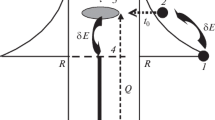Abstract
We consider peculiarities in the formation of a coherent correlated state (CCS) of a particle in a periodically modulated harmonic oscillator with damping for various types of stochastic perturbation. It is shown that in the absence of stochastic perturbation, an optimal relation exists between the damping parameter (damping coefficient) and the modulation depth, for which the “extrinsic” characteristics of the oscillator (amplitudes of “classical” oscillation and the momentum of a particle) remain unchanged, while the correlation coefficient rapidly increases from |r| = 0 to |r|max ≈ 1; this corresponds to a completely correlated coherent state. Under nonoptimal conditions, the formation of the CCS with a simultaneous increase in is accompanied by damping or excitation of the oscillator. It is shown that for a certain relation between the damping coefficient and the modulation depth, the presence of a stochastic external force acting on the nonstationary oscillator does not prevent the formation of a CCS with |r|max → 1. A fundamentally different effect is observed under a stochastic influence on the nonstationary frequency of the oscillator; this effect always limits the value of |r| at a level |r|max < 1; a CCR cannot be formed with an unlimited increase in its intensity, and |r|max → 0. The influence of the CCS formation on the averaged probability 〈D〉 of the tunnel effect (transparency of the potential barrier) is considered for a particle in an oscillator with damping both in the absence and in the presence of a stochastic force. It is shown using a specific example that complete clearing of the potential barrier and the increase in the barrier transparency from the initial value 〈D r=0〉 = 10−80 to 〈D〉 ≈ 1 can occur over a comparatively short time interval in both these cases. These effects can be used to obtain highly efficient nuclear fusion at a low energy of interacting particles.
Similar content being viewed by others
References
V. V. Dodonov and V. I. Man’ko, Tr. Fiz. Inst. im. P. N. Lebedeva, Akad. Nauk SSSR 183, 71 (1987).
V. V. Dodonov, A. B. Klimov, and V. I. Man’ko, Tr. Fiz. Inst. im. P. N. Lebedeva, Akad. Nauk SSSR 200, 56 (1991).
V. I. Vysotskii and S. V. Adamenko, Tech. Phys. 55(5), 613 (2010).
V. I. Vysotskii, M. V. Vysotskyy, and N. V. Maksyuta, Poverkhnost 4(4), 696 (2010).
V. I. Vysotskii, M. V. Vysotskyy, and S. V. Adamenko, JETP 114(2), 243 (2012).
E. Schrödinger, Sitzungsber. Akad. Wiss. Berlin 24, 296 (1930).
H. P. Robertson, Phys. Rev. A: At., Mol., Opt. Phys. 35, 667 (1930).
D. Bohm, Quantum Theory (Prentice Hall, New York, 1951; Nauka, Moscow, 1965).
B. N. Zakhar’ev and V. N. Chabanov, Submissive Quantum Mechanics: New Status of the Theory in Inverse Problem Approach (Regular and Chaotic Dynamics, Izhevsk, 2002; Nova Science, New York, 2008).
H. Dekker, Phys. Rep. 80, 1 (1981).
I. Averbukh, B. Sherman, and G. Kurizki, Phys. Rev. A: At., Mol., Opt. Phys. 50, 5301 (1994).
O. V. Man’ko, Nuovo Cimento B 111, 1111 (1996).
P. Caldirola, Nuovo Cimento 18(9), 393 (1941).
E. Kanai, Prog. Theor. Phys. 3, 440 (1948).
R. W. Hasse, J. Math. Phys. 16, 2005 (1975).
U. Weisse, Quantum Dissipative System (World Scientific, Singapore, 1993).
J. R. Choi and K. H. Yeon, Ann. Phys. 323, 812 (2008).
G. J. Papadopoulos, J. Phys. A: Math., Nucl. Gen. 6, 1479 (1973).
I. R. Svin’in, Theor. Math. Phys. 27 (2), 478 (1976).
R. Alicki and J. Messer, J. Phys. A: Math. Gen. 15, 3543 (1982).
V. V. Dodonov, Phys. Rev. A: At., Mol., Opt. Phys. 80, 023814 (2009).
S. M. Rytov, Principles of Statistical Radiophysics Vol. 1: Elements of Random Process Theory (Nauka, Moscow, 1978; Springer, Berlin, 1987), Chap. V.
V. V. Dodonov, Phys. Rev. A: At., Mol., Opt. Phys. 58, 4147 (1998).
B. R. Mollow, Phys. Rev. A: At., Mol., Opt. Phys. 2, 1477 (1970).
L. Ferrari, Phys. Rev. B: Condens. Matter 56, 593 (1997).
L. Ferrari, Phys. Rev. A: At., Mol., Opt. Phys. 57, 2347 (1998).
J. Garnier, Phys. Rev. E: Stat. Phys., Plasmas, Fluids, Relat. Interdiscip. Top. 60, 3676 (1999).
V. Dodonov, A. B. Klimov, and V. I. Man’ko, Phys. Lett. A 220, 41 (1996).
Controlled Nucleosynthesis: Breakthroughs in Experiment and Theory, Ed. by S. V. Adamenko, F. Selleri, and A. van der Merwe (Springer, Berlin, 2007).
T. Mizuno, T. Akimoto, A. Takahashi, and F. Celani, in Proceedings of the Eleventh International Conference on Cold Fusion, Marseilles, France, October 31–November 5, 2004 (World Scientific, Singapore, 2006), p. 312.
J. Michell, Rossi’s eCat (Xecnet, 2011).
Author information
Authors and Affiliations
Corresponding author
Additional information
Original Russian Text © V.I. Vysotskii, S.V. Adamenko, M.V. Vysotskyy, 2012, published in Zhurnal Eksperimental’noi i Teoreticheskoi Fiziki, 2012, Vol. 142, No. 4, pp. 627–643.
Rights and permissions
About this article
Cite this article
Vysotskii, V.I., Adamenko, S.V. & Vysotskyy, M.V. The formation of correlated states and the increase in barrier transparency at a low particle energy in nonstationary systems with damping and fluctuations. J. Exp. Theor. Phys. 115, 551–566 (2012). https://doi.org/10.1134/S1063776112080183
Received:
Published:
Issue Date:
DOI: https://doi.org/10.1134/S1063776112080183



